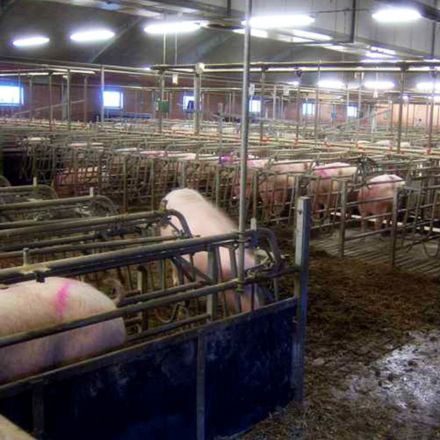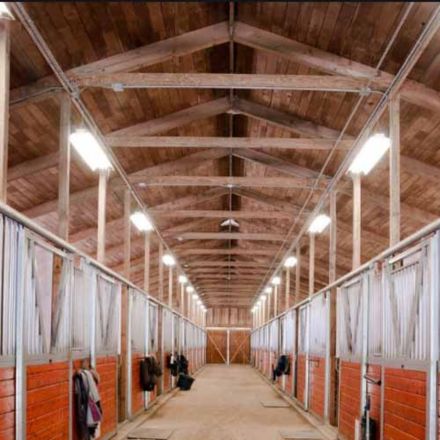Why Lighting Matters in Poultry Farming
The Science Behind the Glow Impact on Egg Production and Broiler Growth
Lighting is more than just illumination in poultry farming—it’s a crucial factor that directly influences the productivity and health of your flock. Whether you’re raising layers for egg production or broilers for meat, the right lighting setup impacts growth rates, feed efficiency, and overall flock performance.
How Light Affects Egg Production
Egg production in laying hens is highly sensitive to lighting schedules and light quality. The right LED poultry light spectrum mimics natural daylight, stimulating the hens’ reproductive system. This triggers hormone production responsible for egg laying. Studies show hens exposed to well-designed poultry farm lighting schedules can increase egg output by up to 10-15%.
Key points on egg production lighting:
- Optimal lux levels for laying hens generally range between 10 to 20 lux; too bright or too dim can disrupt cycles.
- Consistent photoperiods (day length) influence hens’ internal clocks, boosting egg quantity and quality.
- LED lights for egg production provide a stable, energy-efficient source that closely matches natural light wavelengths important for poultry.
Lighting and Broiler Growth
Broiler chickens respond differently to light compared to layers. Here, the focus is growth rate and feed conversion efficiency. Proper lighting reduces stress, encourages healthy activity, and improves feed intake.
Important lighting factors for broilers include:
- Verwendung energy-efficient barn lighting like LED reduces heat output and lowers electricity bills.
- Balanced light intensity supports muscle development without overstimulating or causing unnecessary stress.
- Strategic use of dimmable LED fixtures for farms helps adjust light according to growth phases, improving overall broiler health and weight gain.
Science Behind the Glow
The benefits of LED poultry lighting originate from its ability to emit targeted wavelengths. Red and green wavelengths improve growth hormones and appetite, while blue light can calm birds, reducing aggressive behavior. It’s this science-backed light spectrum that makes LED poultry lights superior to traditional fluorescent poultry lights.
Switching to LED poultry lights means investing in precision farming tools that improve egg production and broiler growth through controlled, consistent light environments.
Ready to harness the science behind poultry lighting? Let’s explore the advantages of switching to LED poultry lights next.
Why Lighting Matters in Poultry Farming Health Benefits Reducing Mortality and Boosting Immunity
Lighting in poultry farming goes beyond just making things visible—it plays a critical role in bird health and survivalcURL Too many subrequests.
How Lighting Influences Poultry Health
- cURL Too many subrequests. cURL Too many subrequests.
- cURL Too many subrequests. cURL Too many subrequests.
Reducing Mortality Rates
cURL Too many subrequests. cURL Too many subrequests.cURL Too many subrequests.
Support for Overall Bird Welfare
- cURL Too many subrequests. cURL Too many subrequests.
- Consistent cURL Too many subrequests. cURL Too many subrequests.
cURL Too many subrequests. cURL Too many subrequests. cURL Too many subrequests.
Advantages of Switching to LED Poultry Lights
Wechsel zu cURL Too many subrequests. cURL Too many subrequests.
Energieeffizienz und Kosteneinsparungen
cURL Too many subrequests. EnergieeffizienzcURL Too many subrequests.
- cURL Too many subrequests. 70% less energy than traditional lighting.
- Longer lifespan reduces replacement frequency and maintenance costs.
- Lower heat output reduces cooling costs in climate-controlled barns.
Improved Poultry Light Spectrum Benefits
LED poultry lights can be tailored to emit specific light wavelengths that match poultry’s natural needs, optimizing the poultry light spectrum benefits.
- Boosts egg production by promoting hormonal balance in laying hens.
- Supports faster broiler growth under artificial light.
- Enhances flock behavior and reduces stress by mimicking natural daylight patterns.
Better Control with Dimmable LED Fixtures
Most LED setups come with dimmable fixtures for farms, giving farmers more control over light intensity. Adjusting lux levels to the age and activity of chickens can lead to:
- Reduced aggression and pecking in flocks.
- Improved sleep cycles and overall welfare.
- Customized lighting schedules that align with natural rhythms.
Durability and Reliability for Poultry Farms
LED poultry lights are built to withstand barn conditions better than traditional bulbs, offering:
- Resistance to vibration, dust, and moisture typical in poultry houses.
- Fewer outages during critical production periods.
- Lower replacement and labor costs over time.
Environmental Impact and Local Farming Benefits
LED lights also offer an eco-friendlier solution, helping farms reduce their carbon footprint with less energy waste and longer-lasting parts. Many U.S.-based farms can source quality LED fixtures locally, supporting regional suppliers and ensuring faster service.
In short, switching to LED poultry lights means better energy savings, healthier flocks, improved production rates, and long-term durability. These advantages make LEDs a smart investment for any poultry operation looking to stay competitive and sustainable.
How to Choose the Right LED Poultry Lights for Your Setup Key Specs to Evaluate
Die richtige Auswahl LED poultry light for your farm isn’t just about buying the cheapest bulb. You want lights that support your birds’ health, improve egg production, and help broiler growth—all while keeping energy costs down. Here’s what you need to focus on when choosing LED lights for your setup.
Light Spectrum and Color Temperature
- Look for the right spectrum: Poultry respond best to specific light wavelengths. Red and blue light wavelengths have been proven to boost egg production and encourage healthy growth. Avoid plain white light that lacks these specific benefits.
- Aim for a color temperature between 2700K and 3500K. This warm spectrum mimics natural sunrise and sunset, which is easier on hens, reduces stress, and promotes laying.
Brightness and Lux Levels
- The correct lux level (light intensity) is critical. For laying hens, maintain cURL Too many subrequests., which encourages steady egg production without over-stressing the birds.
- For broilers or younger birds, slightly higher lux levels around 15 to 20 lux can support better feeding and growth.
- cURL Too many subrequests.
cURL Too many subrequests.
- cURL Too many subrequests. cURL Too many subrequests. cURL Too many subrequests.
- cURL Too many subrequests. cURL Too many subrequests.cURL Too many subrequests.
Dimmable and Adjustable Fixtures
- cURL Too many subrequests. cURL Too many subrequests.
- cURL Too many subrequests.
Durability and IP Rating
- cURL Too many subrequests. cURL Too many subrequests.cURL Too many subrequests. cURL Too many subrequests.cURL Too many subrequests.
- cURL Too many subrequests.
Compatibility with Wiring and Controls
- cURL Too many subrequests. cURL Too many subrequests. cURL Too many subrequests.
- Some LED poultry lights support smart controls and timers that align with optimized poultry farm lighting schedules, making daily management a breeze.
of Key Specs to Evaluate
| Spezifikation | Recommended Feature | Warum es wichtig ist |
|---|---|---|
| Light Spectrum | Red and blue wavelengths, 2700K–3500K | Supports natural behaviors and egg laying |
| Lux Levels | 10-15 lux for layers, 15-20 lux for broilers | Prevents stress and promotes growth |
| Energieeffizienz | High lumen/watt ratio | Saves on electricity costs |
| Lebensdauer | 25.000+ Stunden | Reduces frequent replacements |
| Dimmbar | cURL Too many subrequests. | Controls stress and simulates natural light |
| Durability/IP Rating | cURL Too many subrequests. | Protects against dust and moisture |
| Control Compatibility | Supports timers and smart controls | Makes managing light schedules easier |
By carefully considering these specs, you’ll pick LED poultry lights that support your birds’ health, boost production, and fit your farm’s specific needs. This way, you get the most out of your investment and create a better environment for your flock.
How to Choose the Right LED Poultry Lights for Your Setup Types of LED Fixtures for Poultry
cURL Too many subrequests. cURL Too many subrequests. for your farm, understanding the different types of fixtures available is key to matching your setup and getting the most out of your investment. Each type serves specific purposes, from improving egg production to supporting broiler growth under artificial light.
Overhead LED Fixtures
These are the most common fixtures for large-scale poultry houses. Mounted on ceilings or rafters, overhead LED lights provide even, wide coverage to maintain consistent lux levels for laying hens and broilers. They help mimic natural daylight patterns while saving energy compared to traditional lighting.
- Best for large barns and commercial poultry farms
- Provide broad and uniform illumination across the coop
- Compatible with dimmable LED drivers for flexible lighting schedules
Tube-style LED Bulbs
Tube-style LEDs often replace old fluorescent tubes in chicken coops and hatcheries. They offer a smooth transition from older lighting setups and are known for their energy-efficient barn lighting benefits.
- Easy retrofit into existing fixtures
- Great for hatcheries and smaller poultry houses
- Provide stable poultry light spectrum benefits that support chick development
Spot and Directional LED Fixtures
Spot LEDs are ideal for targeted lighting in brooders or nesting areas. These fixtures allow more control to highlight specific zones, improving behavior and reducing stress.
- Suitable for focused light in brooders or early chick stages
- Help in managing cURL Too many subrequests. precisely
- Can be used alongside overhead lighting for layered illumination
Waterproof and Dustproof LED Fixtures
Poultry barns are tough environments, so choose fixtures rated for moisture and dust resistance. These protect your investment and reduce maintenance hassles.
- Designed for wet, dusty barn conditions
- Longer-lasting performance with minimal downtime
- cURL Too many subrequests.
Integrated Smart LED Systems
cURL Too many subrequests.
- cURL Too many subrequests.
- cURL Too many subrequests. LED lights for egg production cURL Too many subrequests.
- cURL Too many subrequests.
Key Takeaway
cURL Too many subrequests. cURL Too many subrequests.cURL Too many subrequests.
How to Choose the Right LED Poultry Lights for Your Setup Budget and Local Sourcing Tips
Die Auswahl des perfekten cURL Too many subrequests. cURL Too many subrequests.


Set a Realistic Budget Focus on Value Not Just Price
- cURL Too many subrequests. cURL Too many subrequests.
- cURL Too many subrequests. cURL Too many subrequests.
- cURL Too many subrequests. cURL Too many subrequests.
Shop Locally for Faster Support and Reduced Shipping Costs
- cURL Too many subrequests. cURL Too many subrequests.
- cURL Too many subrequests. better after-sales customer service and warranty support, critical for farm setups where downtime can impact production.
- cURL Too many subrequests. regional LED poultry light suppliers who understand specific needs related to climate and building types common in your area.
Take Advantage of Bulk Purchasing and Deals
- If you’re outfitting a large barn or multiple coops, look for volume discounts or bundled deals on LED lights for egg production and broiler growth.
- Some suppliers offer packages that include installation advice or warranty extensions, adding value beyond just the lights.
Verify Compatibility and Lighting Specs
- Stick to LED poultry lights that meet recommended lux levels for laying hens and the ideal poultry light spectrum benefits.
- Check if the LEDs are dimmable or programmable, which supports customized lighting schedules for better flock welfare and productivity.
Where to Find Reliable LED Poultry Lights
For a thorough guide on various LED lighting options that cater to farms and other setups, visiting detailed resources like this 6ft LED Batten Lights UK Guide offers insights into energy-efficient LED fixtures useful for poultry environments. Though based in the UK, many principles apply and can help you evaluate features and brands.
By setting a clear budget and sourcing locally, you reduce unexpected costs and ensure your poultry lighting system performs reliably for years—boosting egg production, lowering mortality, and improving your farm’s bottom line.
Step-by-Step Installation and Management Guide Planning Your Layout for LED Poultry Lights
When it comes to installing LED poultry lights, planning your layout is a critical first step. A well-designed lighting setup ensures consistent light distribution, optimal lux levels for laying hens or broilers, and maximizes energy efficiency in your poultry house.
Assess Your Existing Setup
- Measure the size and shape of your poultry barns or chicken coops.
- Identify areas needing the most illumination, such as feeding zones, nesting boxes, and brooding areas.
- Note current light sources and their locations to integrate or replace them smoothly.
Determine Lighting Needs Based on Poultry Type
- Egg production demands steady, moderate lighting to maintain consistent laying cycles.
- Broiler growth benefits from targeted light spectrums with varied lux levels to encourage feeding and activity.
- Adjust lighting intensity and positioning accordingly to support these needs.
Choose Proper Light Spacing and Height
- Mount LED fixtures at heights that provide uniform light spread without hot spots or dark corners.
- For most poultry setups, spacing should aim for balanced coverage, avoiding over-illumination that could stress the flock.
- Use tools like light meters to verify cURL Too many subrequests. meet recommended lux levels.
Plan for Wiring and Control Accessibility
- Design the layout with easy access to wiring paths and switch controls.
- Include options for dimmable LED fixtures for farms to adjust lighting schedules conveniently.
- cURL Too many subrequests.
Prioritize Energy Efficiency and Safety
- cURL Too many subrequests.
- cURL Too many subrequests.
- cURL Too many subrequests.
cURL Too many subrequests. energy-efficient barn lighting cURL Too many subrequests. cURL Too many subrequests. cURL Too many subrequests.
cURL Too many subrequests. cURL Too many subrequests. cURL Too many subrequests.
Step-by-Step Installation and Management Guide Wiring and Controls for LED Poultry Light
cURL Too many subrequests. cURL Too many subrequests. cURL Too many subrequests. energy-efficient barn lighting cURL Too many subrequests.
cURL Too many subrequests.
cURL Too many subrequests.
- cURL Too many subrequests.
- cURL Too many subrequests.
- cURL Too many subrequests.
cURL Too many subrequests.
Verwenden Sie cURL Too many subrequests.—resistant to dust, moisture, and temperature changes common in chicken barns. Typical recommendations:
- Verwenden Sie outdoor-rated, waterproof cables like UF or THWN wires
- Ensure wires have sufficient gauge to handle the load without voltage drop, especially for long runs
- Ground all fixtures and control panels properly to avoid electrical hazards
cURL Too many subrequests.
Automated controls are key for managing cURL Too many subrequests. efficiently:
- Timers or programmable controllers allow you to mimic natural day and night cycles, essential for egg production and broiler growth
- Consider dimmable LED fixtures paired with dimming controllers to simulate dawn and dusk phases, reducing stress on birds
- Remote or app-controlled lighting systems can offer added flexibility, letting you adjust light cycles without entering the coop
cURL Too many subrequests.
Protect your setup with the right circuit breakers and fuses:
- Verwenden Sie dedicated circuits for your LED poultry lights to avoid overloading
- Add surge protectors to handle unexpected voltage spikes, which can shorten LED lifespan
- Confirm breakers match the electrical code requirements for agricultural facilities in your state
cURL Too many subrequests.
Before switching the system live:
- Double-check all connections are tight and correctly wired
- Test each fixture individually for proper operation
- Verify that all controls and timers function as intended
cURL Too many subrequests.
- Map out and secure wiring paths
- Use agricultural-grade, weatherproof cables
- Employ timers and dimmers for optimized poultry light spectrum benefits
- Protect circuits with breakers and surge protectors
- Test thoroughly before full operation
Following these steps will ensure your cURL Too many subrequests. operate safely and efficiently, helping you improve egg production, broiler growth, and overall flock health while reducing energy costs.
cURL Too many subrequests.
Maintaining your LED poultry lights properly is key to keeping your cURL Too many subrequests. consistent and ensuring your birds get the right light for health and productivity. Here’s how to get the most out of your investment while avoiding common issues with chicken coop LED bulbs and farm lighting.
cURL Too many subrequests.
Dust, dirt, and poultry dander build up quickly in barn environments, which can dim your lights and reduce their effectiveness.
- Clean light covers and fixtures every 3 to 6 months with a soft cloth and mild cleaner.
- Avoid harsh chemicals that could damage LED lenses or coatings.
- Keep fans or vents near lights free from dust to improve cooling and prolong lifespans.
cURL Too many subrequests.
Faulty wiring can cause flickering, reduced brightness, or complete outages.
- Check wiring and electrical connections at least twice a year.
- Look for signs of wear, corrosion, or loose connectors—fix these immediately.
- cURL Too many subrequests.
cURL Too many subrequests.
cURL Too many subrequests. lux levels for laying hens cURL Too many subrequests.
- cURL Too many subrequests.
- cURL Too many subrequests.
- cURL Too many subrequests.
cURL Too many subrequests.
cURL Too many subrequests.
- cURL Too many subrequests.
- cURL Too many subrequests. poultry light spectrum benefits.
cURL Too many subrequests.
cURL Too many subrequests.
- cURL Too many subrequests.
- cURL Too many subrequests.
cURL Too many subrequests.
cURL Too many subrequests.
- cURL Too many subrequests.
- cURL Too many subrequests.
cURL Too many subrequests. cURL Too many subrequests.cURL Too many subrequests.
cURL Too many subrequests.
cURL Too many subrequests. lighting schedules with your LED poultry lights is key to boosting productivity and health on your farm. Different types of flocks—like layers, broilers, or breeders—require different light durations and intensities to perform their best.
cURL Too many subrequests.
Für egg production, laying hens thrive under consistent lighting that mimics natural daylight. Here’s what works best:
- 14 to 16 hours of light daily: Helps maintain steady egg-laying cycles.
- Light intensity around 10 to 15 lux: Enough to encourage feeding and activity without stressing the hens.
- Verwenden Sie warm white LED lights to promote calm behavior and reduce aggression.
- cURL Too many subrequests. gradual transitions between light and dark periods to avoid sudden stress.
cURL Too many subrequests.
Broilers need a different approach focused on growth and welfare:
- cURL Too many subrequests. 23 hours of light for the first few days to encourage eating and adaptation.
- Reduce to 16 to 18 hours of light as they age, giving 6 to 8 hours of dark to support rest.
- Keep light intensity higher—15 to 20 lux—to promote activity and feed intake.
- Verwenden Sie cool white LED lighting; this spectrum supports better growth rates.
cURL Too many subrequests.
Breeders and hatchery setups have unique demands:
- Day length should be carefully controlled to match reproductive cycles—often around 12 to 14 hours of light.
- Use dimmable fixtures to replicate dawn and dusk, which helps regulate hormone levels.
- Maintain stable lighting schedules to avoid disrupting egg fertility and hatch rates.
- Adjust lux levels depending on bird age—usually moderate lighting, around 10 to 12 lux, works best here.
cURL Too many subrequests.
- Always aim for consistency—routine lighting reduces stress and improves flock health.
- Avoid sudden changes in light duration or intensity.
- Verwenden Sie energy-efficient barn lighting to save costs while optimizing output.
- Consider your local climate and daylight hours when setting schedules, especially in regions with shorter winter days.
Getting your LED poultry light schedule right isn’t just about saving energy; it’s about maximizing flock performance, health, and productivity. Tailor your setup to your flock’s specific needs, and you’ll notice better results across the board.
cURL Too many subrequests.
cURL Too many subrequests. cURL Too many subrequests. cURL Too many subrequests.
Flickering or Inconsistent Light Output
cURL Too many subrequests. cURL Too many subrequests.
cURL Too many subrequests.
- cURL Too many subrequests.
- cURL Too many subrequests.
- cURL Too many subrequests.
- cURL Too many subrequests.
Incorrect Lighting Schedules Impacting Behavior
cURL Too many subrequests. cURL Too many subrequests.
cURL Too many subrequests.
- cURL Too many subrequests. cURL Too many subrequests..
- cURL Too many subrequests.
- cURL Too many subrequests.
Overheated Fixtures in Confined Spaces
cURL Too many subrequests. cURL Too many subrequests.
cURL Too many subrequests.
- cURL Too many subrequests.
- cURL Too many subrequests.
- cURL Too many subrequests.
Uneven Light Distribution Causing Stress
cURL Too many subrequests. cURL Too many subrequests.
cURL Too many subrequests.
- cURL Too many subrequests.
- Use fixtures with adjustable beam angles or add reflectors.
- Consider modular panels for better control, see our guide on Hexagon LED-Lichter for setup inspiration.
Flicker from Incompatible Controls
cURL Too many subrequests. Some LED lights flicker or behave erratically with poorly matched dimmers or control systems.
cURL Too many subrequests.
- Match LED drivers and controllers as per manufacturer specs.
- Invest in smart dimmable LED fixtures for flexibility.
- Avoid cheap or low-quality control gear.
Power Surges and Electrical Issues
cURL Too many subrequests. Power surges can damage LEDs quickly, leading to downtime and higher costs.
cURL Too many subrequests.
- Install surge protectors on your lighting circuit.
- Regularly inspect wiring and replace worn cables.
- Incorporate emergency LED backup solutions if power instability is common in your area.
of Best Practices
- Verwenden Sie energy-efficient barn lighting tailored for poultry.
- Maintain proper wiring and compatible dimmers.
- Follow consistent, species-appropriate lighting schedules.
- Ensure even, comfortable light coverage.
- Source quality LED fixtures with robust heat management.
Addressing these challenges head-on helps maximize the benefits of LED poultry lighting—from improved egg production to healthier, faster-growing broilers. For detailed lighting schedules and control tips, check out our full guide to LED bulkhead luminaires and their role in poultry setups.
Real Farm Wins with Prillumen LED Poultry Light
Wenn es um cURL Too many subrequests. making a real difference, Prillumen has several success stories that stand out. Farmers across the U.S. have switched to these energy-efficient barn lighting solutions and noticed measurable improvements in their flock’s performance.
Increased Egg Production and Broiler Growth
Many poultry farmers using Prillumen LED lights report significant boosts in egg production. These LED lights provide a tailored poultry light spectrum that matches the birds’ natural needs, enhancing laying hens’ comfort and health. For broiler growers, the carefully controlled lighting has resulted in faster growth rates and better feed conversion ratios.
Improved Chicken Health and Reduced Mortality
Healthy flocks mean fewer losses and lower vet bills. Prillumen’s LED solutions promote better immunity and reduced stress by mimicking natural daylight patterns more closely than old fluorescent setups. This has led to noticeable drops in mortality rates and conditions related to poor lighting, like leg disorders.
Energy Savings and Maintenance Efficiency
Switching to Prillumen LED poultry lights doesn’t just benefit the birds. Many farms have cut down on electricity costs by up to 50% with these energy-efficient fixtures. Plus, their long lifespan and low maintenance requirements save time and money on replacements and repairs.
Practical Takeaways
- Farms optimizing cURL Too many subrequests. with dimmable LED fixtures see better flock behaviors and productivity.
- cURL Too many subrequests. lux levels for laying hens keeps them active and healthy without overexposure.
- Installing these lights in hatcheries and broiler barns ensures consistent growth under artificial light while maintaining natural rhythms.
Prillumen LED poultry lights have proven their value on the ground. From increased egg output to healthier chickens and lower energy bills, these lights are reshaping poultry farming in practical, profitable ways. If you’re ready to upgrade your setup, their smart, customizable lighting could be exactly what your farm needs.






Einen Kommentar hinterlassen